Apple iPad mini with Retina Display: Reviewed
by Anand Lal Shimpi on November 16, 2013 8:00 AM ESTThe Display
The big story behind the new iPad mini is of course its 7.85-inch Retina Display. We’re talking about the same 2048 x 1536 resolution as the iPad Air, but in a much smaller form factor. The result is the highest pixel density of any Apple display ships today, tying with the iPhone 5S. The impact on the overall experience is pretty significant. Text is obviously a lot sharper, but even graphics are a lot nicer to look at on the new Retina Display. The gains aren't quite as obvious as they were on the larger iPad, but after living with the Retina mini for a while I can't easily go back to the previous version.

iPad mini (left) vs. iPad mini with Retina Display (right)
I ran Marco Arment's image retention test on the Retina mini and didn't see even the slightest degree of image retention. My old, non-Retina iPad mini on the other hand exhibited image retention. I suspect Apple is multi-sourcing its displays here, which could obviously contribute to varied behavior. At least on the two minis I have, image retention isn't an issue.
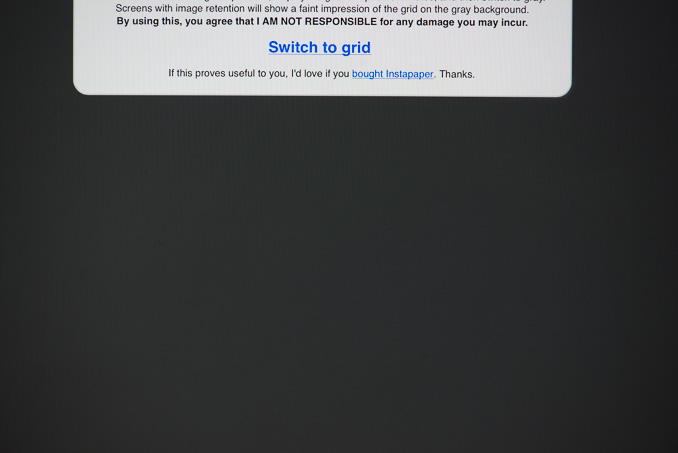
In the conclusion of my iPad Air review I wrote about the new mini as finally being a no-compromises smaller iPad. Much like my assertions last year of a Retina mini not being in the cards, it turns out that I was wrong on this point as well. Although display resolution is no longer a concern on the mini, color gamut hasn’t changed between the old and new minis. A quick look at our gamut test gives us an idea of what’s going on:

The iPad mini with Retina Display has the same color gamut as the standard iPad mini, which is narrower than the iPad Air and less than the sRGB coverage we normally look for. The biggest issue here is that there are other smaller tablets in this price range that do offer sRGB coverage (e.g. Nexus 7, Kindle Fire HDX 8.9).
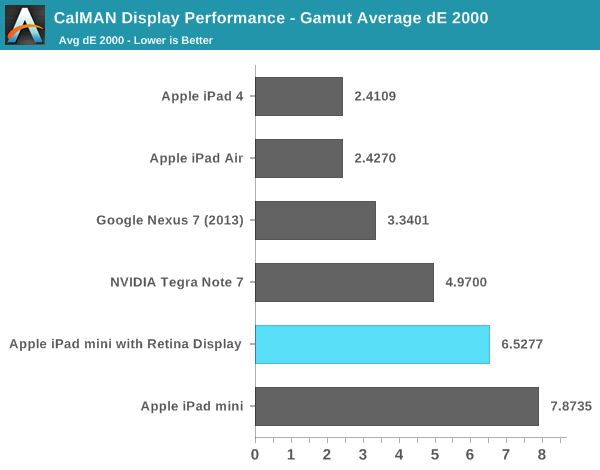
I suspect the justification here is Apple likely views the bigger iPad as being a better fit for photographers/those who care about color reproduction, but it’s a shame that this is a tradeoff that exists between the two iPads especially given how good Apple is about sRGB coverage in nearly all of its other displays.
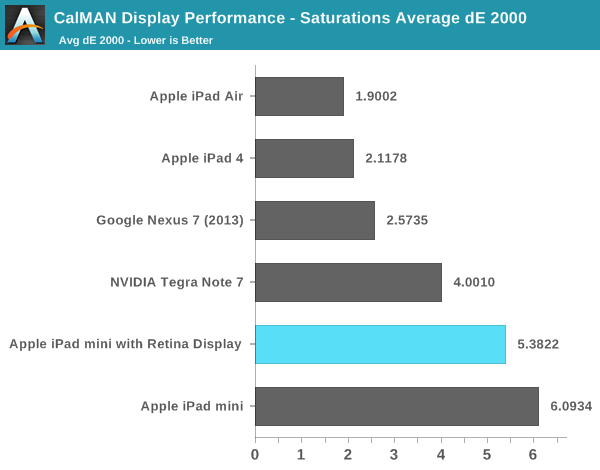

One of the simplest visual tests is to use one of iOS 7’s more colorful wallpapers and compare the Retina mini and iPad Air side by side:
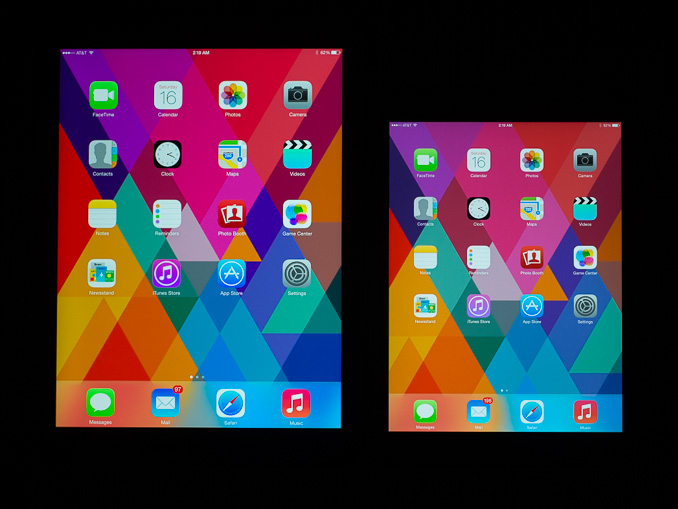
Pay attention to the color of the red triangles in the lower left
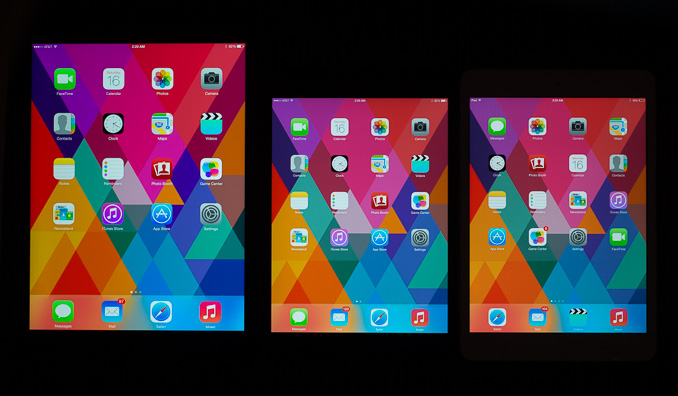
From left to right: iPad Air, iPad mini with Retina Display, iPad mini
The difference is small but apparent, particularly if you’re used to panels with full sRGB coverage like the iPad Air or any of the rMBPs/iMacs. The biggest deviations are in reds/blues and magenta in between as you can tell from the CIE chart above.

Within its gamut coverage, the mini’s panel is fairly accurate. A look at our GMB checker test shows performance competitive with the Nexus 7 and not far off the 4th generation iPad. Grayscale reproduction is also quite good. The display looks really good otherwise, but you don’t get the same visual punch you do on the iPad Air.
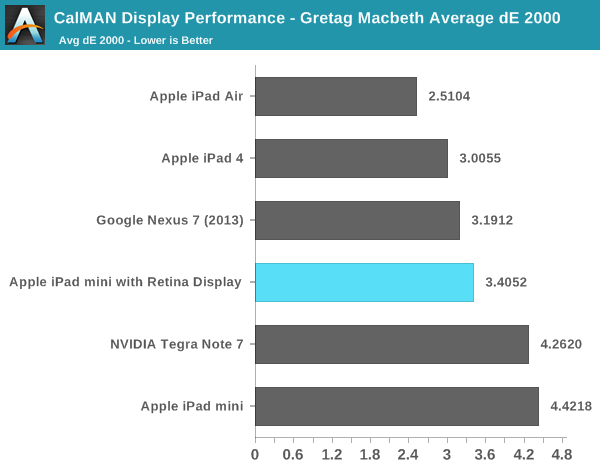

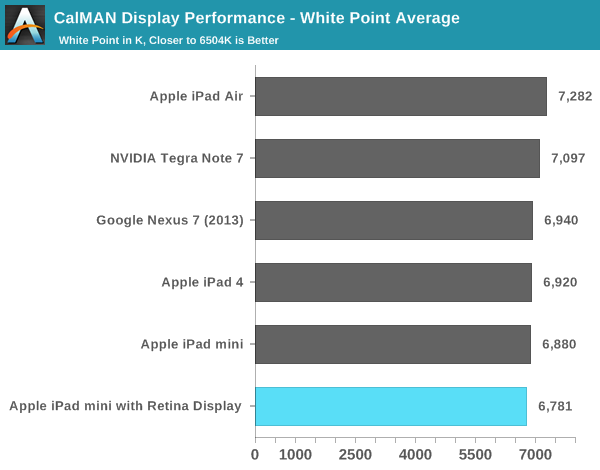
Compared to the previous generation mini we’re obviously talking about a much better panel. But for those of you on the fence between the mini and Air, the Air does still hold a display advantage.
Black levels are competitive and contrast ratio stays fixed at around 800:1 regardless of whether we’re talking about max brightness or the 200 nits we run all of our battery life tests at. Max brightness is down a bit compared to the iPad Air.
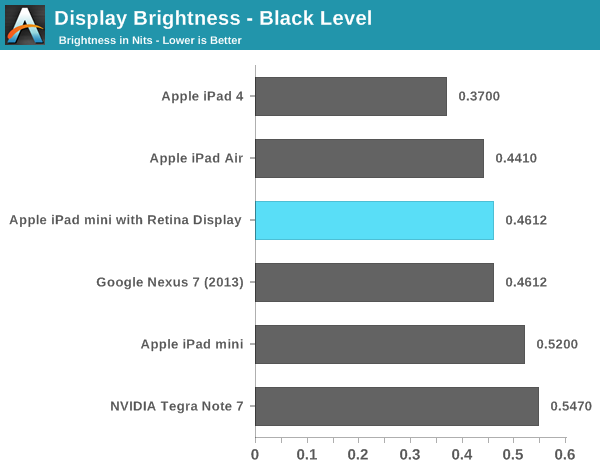
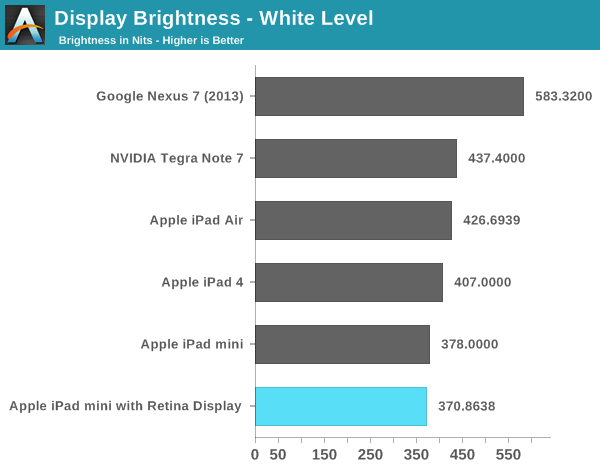
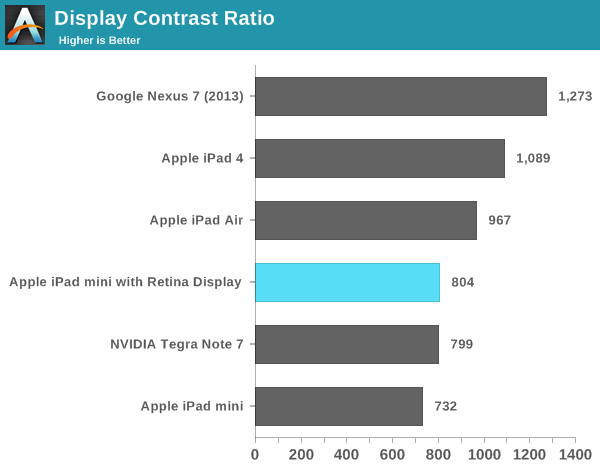










345 Comments
View All Comments
allanwood - Sunday, November 17, 2013 - link
I just checked the iPad Mini w/ Retina at the store yesterday, and it doesn't have a bonded display, just like the first mini.The easiest way to check for a space between the LCD and cover glass is to look at a reflection of a light in the screen at an angle. If you see a strong reflection and a weaker one, it has a gap. One strong reflection means it doesn't.
Spoony - Monday, November 18, 2013 - link
I am quite sure that the original Mini had optically bonded glass and panel. Multiple technical publications including this one I believe have stated that the originally Mini is that way. Additionally, my limited in-person experience with the Mini have definitely shown it to be bonded.allanwood - Monday, November 18, 2013 - link
Nope. This is from DisplayMate:"The Kindle Fire HD and and Nexus 7 both have their Cover Glass bonded directly to the LCD so there is no Air Gap like on the iPad mini, which has 3 widely separated reflections. The lack of an Air Gap helps to reduce the Reflectance for Ambient Light."
versesuvius - Saturday, November 16, 2013 - link
Apple is the company of few products and huge resources, with a brand name to boot (as in it will be bought no matter what). There are other companies with the same level or resources but they make many products. Samsung produces hundreds, perhaps thousands of individual products. Hundreds of phones. Apple produces one at a time. Nothing wrong with that, but while there is nothing that Samsung can learn from Apple, smaller companies could learn a lot from Apple. The way technology is advancing and getting cheap to the point of irrelevance, those companies could sink deadly bites into Apple, to the benefit of all around the world.KPOM - Saturday, November 16, 2013 - link
Nice review as always. Thanks for confirming our suspicions about the color gamut. I have both the Air and retina mini right now and noticed a difference. I think I'll still keep the mini and return the Air, though. The portability trounces the display difference for me.I have noticed that both the Air and the Retina Mini seem twitchy with my Sprint Aircard (Sierra Wireless 803s). It is somewhat moot for me as I bought the LTE versions, but I noticed this behavior with two different iPad Airs and the retina mini. It struggles to connect in the first place, and frequently disconnects. I did not notice this at all with the previous mini, and when I tested it with the iPhone 5s it seemed to work fine. I suspect an incompatibility somewhere as both an extended chat session and Genius Bar trip couldn't resolve the issue (we tried numerous different rested and setting changes). I haven't tried it with the wifi-only version, but I'm curious if this is a larger issue and/or something that can be resolved through firmware. I also noticed the Air had a harder time than my PC at connecting to a hotel wifi network but it eventually did (I'll experiment with the mini next week). I haven't noticed any issues connecting to Apple Airport-driven wifi networks but still need to test it with non-Apple routers.
KPOM - Saturday, November 16, 2013 - link
Are there other reasons why Apple might have chosen a lower gamut display? Does it impact battery life or is it cheaper to produce? Or is it just one more reason to try to up sell the pricier Air model?Aenean144 - Saturday, November 16, 2013 - link
Yield would be my bet.Morawka - Saturday, November 16, 2013 - link
i'm guessing nobody could make this panel but sharp, since they own IGZO tech. Then again,color could be off because the glue is still wet lol......nunomoreira10 - Saturday, November 16, 2013 - link
The gamut is generally depended on the leds used in the baclight.higher gamut leds are less eficient and more expensive then lower gamut leds, so its a trade-off between battery life and quality.
Morawka - Saturday, November 16, 2013 - link
What do you know? anand doing another apple review.